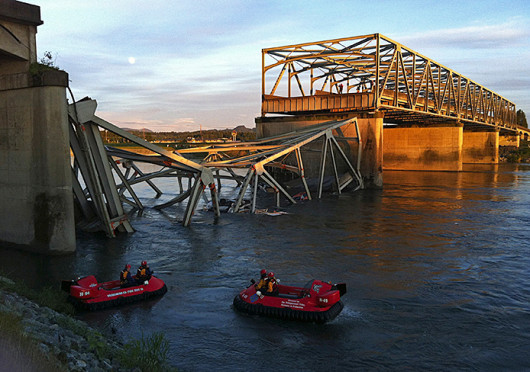
The collapsed bridge where I-5 crosses the Skagit River in Mount Vernon, Wash., May 23. Credit: Courtesy of MCT
Letter to the editor:
In their annual report released earlier this year, The American Society of Civil Engineers gave the United States’ infrastructure a D+ rating . The United States, a country once known for its world-class infrastructure, is now trending toward the bottom of the developed world. Many of our competitors are upgrading their nation’s capital stock every year — particularly China — by adding high-speed rail, upgraded information systems and new roads.
So why aren’t we?
Especially considering all the new technology the U.S. has invented over the past 20 years, why isn’t it being used to upgrade our nation’s capital stock? Why aren’t we building high-speed rail systems that cut travel time and carbon emissions in half? Why aren’t we upgrading our nation’s Wi-Fi speed? Why aren’t we building new utility systems powered with green energy?
Where’s the progress?
It’s not just about economic progress. For example, this year in Mount Vernon, Wash., a semi-truck accidentally impacted one of the overhead tresses of a bridge that is daily used by 70,000 citizens and businesses. This set off a chain reaction, resulting in the 58-year-old bridge nose-diving into the Skagit River. Luckily, nobody died; however, the story illustrates the danger of what can happen if our infrastructure isn’t taken care of.
A public capital upgrade is needed: not only for the sake of remaining economically competitive worldwide, but also clearly for the sake of our citizens’ safety.
Infrastructure spending acts in the short-term as an immediate jolt to our economy. This happens as government expenditure acts as a stimulus, by paying wages to all who participate in the construction. These wages will then be spent throughout the local economies. This effect may be small and temporary, but it’s still a boost.
However, real and long-term economic growth will result from the increased productivity of our nation’s capital stock. We can produce more in less time and with less money, on a nationwide scale.
Another example is high speed rail, which provides a speedier route for businesses to transport goods across the country, thus saving them time and money. Also, upgrading our communication systems and nationwide Wi-Fi speed would expedite how fast and how cheaply information is spread from business to business across our country.
Not only does infrastructure increase productivity: it brings more business to the U.S. Businesses locate where they can save the most money. A KPMG International survey from a few years back found that 90 percent of business executives said that the availability and quality of infrastructure affects where they locate their business operations. Furthermore, businesses locate where the economy is the most productive. If we want more business here in the United States, we need to upgrade our nation’s capital.
It is not necessary that this be done only with public investment. So-called infrastructure banks bring funding from the private sector, and give tax breaks to investors purchasing municipal bonds, which as a result makes money available to local municipalities for infrastructure investment. Both types of investment can facilitate the upgrade we need. But let us see the private sector and the public sector unite to tackle the problem of our crumbling infrastructure: let it happen before the situation becomes dire.
Jonathan Parrish
Fourth-year in economics
Co-President of the Undergraduate Economics Society
[email protected]


